Level 5 or higher monsters that have relied upon being Tribute Summoned have always existed as a part of the game. Across both the TCG and OCG, there have been many attempts to refine the Tribute Summoning mechanic and translate this mechanic as a central theme for only a few archetypes. In this article, I will analyze the difficulty in designing a Tribute Summon-based archetype through the various attempts to tackle these challenges, leading towards the next Tribute Summon-centric archetype that’s coming soon in Maximum Crisis.
The following article is a mix of analysis, logic, and application of my game knowledge. Keep that in mind, as nothing is confirmed by Konami or any official card design sources. This is technically an opinion piece, you have been warned!
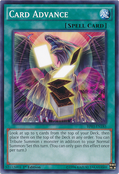
The Dilemmas of the Mechanic:
Before I begin diving into the design details with respect to specific archetypes, let’s begin by covering the basics for Tribute Summoning. Initially designed as a gating mechanism, a Tribute Summon requires 1, 2 or 3 other monsters you control in addition to your turn’s Normal Summon. It was introduced to provide a method of summoning a boss monster at a reasonable ‘cost’ in card advantage. For monsters with Level 5 or 6, most duelists already know that this cost is 1 tribute, and for monsters with Level 7 or higher, this cost is 2 tributes. Now, this was created for the game well before Pendulum, Synchro, or Xyz monsters were even a part of the game designers’ wildest dreams. With this in mind, I want you to take a second to ask yourself a question: How many archetypes can you recall that are centered around Tribute Summoning?
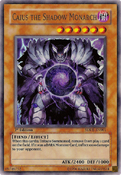 Let me guess, you named Monarchs and perhaps even Qliphort. In actuality, there aren’t too many archetypes centered around this mechanic for one big reason – the downsides to the mechanic were too numerous. To have a boss monster that is summoned via Tribute Summoning, an archetype must be able to spam the field with material (without using the turn’s Normal Summon or by generating additional Normal Summons), get the boss monster to hand, then be able to take a -1 or -2 loss in card advantage in stride without losing momentum… Easy, right? No, it really isn’t. In order to mitigate all of those aforementioned issues, an archetype would have to have search power, spamming capability to the extreme, and effects that activate when they leave the field. It has only been recently, during the Arc-V era, that a single archetype had all of these characteristics. The power level of the game before that simply was not at a high-enough point to support Tribute Summoning as a core mechanic. Be sure to keep that in mind as I begin analyzing specific archetypes and how they attempted to tackle these issues with the mechanic, because it is key to understanding the thought processes of card designers and how we arrive at the current spread of archetypes we have today.
Let me guess, you named Monarchs and perhaps even Qliphort. In actuality, there aren’t too many archetypes centered around this mechanic for one big reason – the downsides to the mechanic were too numerous. To have a boss monster that is summoned via Tribute Summoning, an archetype must be able to spam the field with material (without using the turn’s Normal Summon or by generating additional Normal Summons), get the boss monster to hand, then be able to take a -1 or -2 loss in card advantage in stride without losing momentum… Easy, right? No, it really isn’t. In order to mitigate all of those aforementioned issues, an archetype would have to have search power, spamming capability to the extreme, and effects that activate when they leave the field. It has only been recently, during the Arc-V era, that a single archetype had all of these characteristics. The power level of the game before that simply was not at a high-enough point to support Tribute Summoning as a core mechanic. Be sure to keep that in mind as I begin analyzing specific archetypes and how they attempted to tackle these issues with the mechanic, because it is key to understanding the thought processes of card designers and how we arrive at the current spread of archetypes we have today.
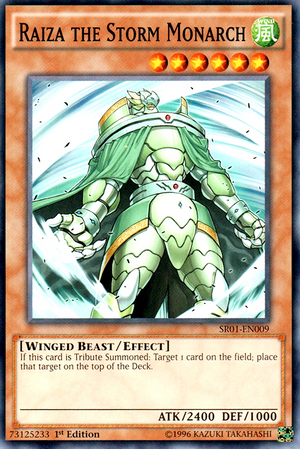
The First Tribute Theme – The Monarchs:
To clarify before I begin, I want to start by introducing the Monarchs as they originally began, back in the GX era. The idea behind this initial theme was extremely simple – they all had effects to balance the cost of a Tribute Summon. Zaborg destroyed a monster upon being Tribute Summoned, Mobius destroyed 2 Spell/Trap cards upon being Tribute Summoned, Thestalos discarded a card from the opponent’s hand, and Granmarg destroyed a set card. Eventually Raiza and Caius were added to the fray, but all of these cards were introduced to compensate for only one of the downsides to the Tribute Summon mechanic: the loss in card advantage. The first attempt at tackling the challenge of the Tribute Summon mechanic only hit one of the downsides, and yet the Monarchs quickly grew to be some of the most dominant cards of their day. These monsters in their prime helped a specific deck rise to the top of the tournament scene to dominate, a deck called Perfect Circle. Thus, it was clear for at least some part of the history of the game that Monarchs could be a game-defining force with the power of Tribute Summoning. Then came the 5Ds era, and Synchro Summoning rose as the premiere boss monsters; Synchro Monsters, that still required the multiple monster investment; however, they eliminated two problems held by Tribute Summon monsters – the requirement of having them in the hand and your turn’s Normal Summon. Thus, to keep pace with the new Synchro overlords, Tribute Summoning had to try to keep up. Thus, card designers did the best they could: design an archetype that could keep up, and can probably be considered the first archetype that was entirely based around Tribute Summoning. Seems fitting for the Hidden Arsenal (DT) series to introduce a theme completely devoted to Tribute Summoning considering that these archetypes intended to support every different type of summoning method.
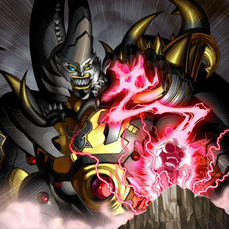
The first Tribute Archetype – Steelswarm:
So we have already covered the initial obstacles with themes centered around Tribute Summoning and the card designers’ first attempts at solving these issues. For the first time, they were fully dedicated to the idea of crafting an archetype to eliminate the downsides of Tribute Summoning. As the Monarchs had previously been a proven concept of how to approach these challenges, the trend of having effects upon Tribute Summoning was a quick shoe-in. However, an archetype is a giant step up from a theme like the Monarchs, because archetypes are supposed to be  designed to be self-sustaining. Thus, the deck needed some Tribute material to use. As Treeborn Frog had been a key element of Monarch decks in the past, it seemed rather obvious to start by making an equivalent source of tribute fodder. Outside of Steelswarm Scout, there was another main form of tribute fodder used back in the day, and those were monsters that could Special Summon themselves from the hand, such as Cyber Dragon. Thus, Steelswarm Cell joined the fray. In addition to the other tools in their arsenal, we can simply check off one requirement – that the Steelswarm archetype had the swarming potential to get Tribute Material to the field. Secondly, they made some of the higher leveled monsters require only 1 Tribute, that way they could make the initial strain on card advantage have less impact. Lastly, they even created the theme to have an amazing recovery tool in the form of Recurring Nightmare, since the majority of the useful monsters within the archetype had 0 DEF.
designed to be self-sustaining. Thus, the deck needed some Tribute material to use. As Treeborn Frog had been a key element of Monarch decks in the past, it seemed rather obvious to start by making an equivalent source of tribute fodder. Outside of Steelswarm Scout, there was another main form of tribute fodder used back in the day, and those were monsters that could Special Summon themselves from the hand, such as Cyber Dragon. Thus, Steelswarm Cell joined the fray. In addition to the other tools in their arsenal, we can simply check off one requirement – that the Steelswarm archetype had the swarming potential to get Tribute Material to the field. Secondly, they made some of the higher leveled monsters require only 1 Tribute, that way they could make the initial strain on card advantage have less impact. Lastly, they even created the theme to have an amazing recovery tool in the form of Recurring Nightmare, since the majority of the useful monsters within the archetype had 0 DEF.
 I understand that in a vacuum, these strengths could sound like the recipe for an extremely strong deck. Quite the opposite actually, it is pretty close to being one of the least functional archetypes from the Hidden Arsenal series. So why did this archetype end up utterly failing? Just as the early Monarchs fell out of favor, the Steelswarm having effects to compensate for losses in card advantage in addition to in-theme tribute fodder were not enough to push this strategy towards viability. Even with the bonus of effective recovery after failed attempts at making plays. What I find extremely interesting about this archetype in particular is that the card designers actually realized their mistake a bit later – they had not met the final characteristic that the theme must have enough search power to get those boss monsters as needed. Infestation Infection was the answer, as it allowed duelists to search any missing piece of their Steelswarm combos; however, it was not released until the Evilswarm archetype. At that point, the game had advanced past needing just a bit of search power for a Tribute Summon archetype to flourish in the Zexal era, and thus the Evilswarm archetype took the place as the only memorable DARK archetype from the Hidden Arsenal packs. Or one could simply say they just converted the Steelswarm into a new archetype to start from scratch since their original design ended so poorly. So how did the card designers respond? How about by forgoing part of the requirement for Tribute Summoning by making the Summon a Special Summon?
I understand that in a vacuum, these strengths could sound like the recipe for an extremely strong deck. Quite the opposite actually, it is pretty close to being one of the least functional archetypes from the Hidden Arsenal series. So why did this archetype end up utterly failing? Just as the early Monarchs fell out of favor, the Steelswarm having effects to compensate for losses in card advantage in addition to in-theme tribute fodder were not enough to push this strategy towards viability. Even with the bonus of effective recovery after failed attempts at making plays. What I find extremely interesting about this archetype in particular is that the card designers actually realized their mistake a bit later – they had not met the final characteristic that the theme must have enough search power to get those boss monsters as needed. Infestation Infection was the answer, as it allowed duelists to search any missing piece of their Steelswarm combos; however, it was not released until the Evilswarm archetype. At that point, the game had advanced past needing just a bit of search power for a Tribute Summon archetype to flourish in the Zexal era, and thus the Evilswarm archetype took the place as the only memorable DARK archetype from the Hidden Arsenal packs. Or one could simply say they just converted the Steelswarm into a new archetype to start from scratch since their original design ended so poorly. So how did the card designers respond? How about by forgoing part of the requirement for Tribute Summoning by making the Summon a Special Summon?
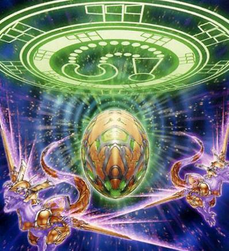
Egyptian Dragons Arise – Introducing the Hieratic:
What happened when card designers tried to completely skip the downside to a mechanic? Hieratic happened. The Hieratic monsters, known for insane swarming capability, have composed one of the few competitive decks in all of the 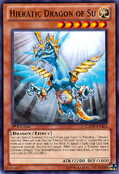 history of competitive play to feature multiple Normal Monsters. While this archetype doesn’t technically Tribute Summon, there’s actually a ton of similarities between Hieratic and Tribute Summon-centric strategies. First, they both rely entirely upon Tributing. There are two Hieratics in particular, Su and Nebthet, that tribute a Hieratic you control to Special Summon themselves from the hand, just like a Tribute Summon, just with the caveat that it doesn’t require your turn’s Normal Summon. The majority of useful Hieratics even activate when they are tributed as well, to summon even more monsters to the field while making up for lost card advantage. So what other characteristics do the Hieratic fulfill? Well they have a searcher for whatever they need in the form of the Spell Card Hieratic Seal of Convocation. They also have recovery in the form of Red-Eyes Darkness Metal Dragon, access to many powerful Extra Deck monsters, the entire suite of Dragon-type support cards… Yes, there is a reason why the remnants of the Hieratic impact on the metagame is still on the Forbidden/Limited List.
history of competitive play to feature multiple Normal Monsters. While this archetype doesn’t technically Tribute Summon, there’s actually a ton of similarities between Hieratic and Tribute Summon-centric strategies. First, they both rely entirely upon Tributing. There are two Hieratics in particular, Su and Nebthet, that tribute a Hieratic you control to Special Summon themselves from the hand, just like a Tribute Summon, just with the caveat that it doesn’t require your turn’s Normal Summon. The majority of useful Hieratics even activate when they are tributed as well, to summon even more monsters to the field while making up for lost card advantage. So what other characteristics do the Hieratic fulfill? Well they have a searcher for whatever they need in the form of the Spell Card Hieratic Seal of Convocation. They also have recovery in the form of Red-Eyes Darkness Metal Dragon, access to many powerful Extra Deck monsters, the entire suite of Dragon-type support cards… Yes, there is a reason why the remnants of the Hieratic impact on the metagame is still on the Forbidden/Limited List.
Now why bring this archetype up in an article about Tribute Summoning? Because I wanted to highlight that card designers actually hit the mark when it comes to designing an archetype that relies upon adding the cards you need to the hand, then relying upon tributing and effective trades of card advantage to get them to the field. Sure, one can claim that the Hieratic is more of a combo-heavy strategy than prior Tribute-focused archetypes, but it does hit the nail on the head and prove that a theme with these heavy restrictions and challenges can still be at the top tables. Thus, the scene was set for future Tribute Summon archetypes… or should I say the return of some powerful Emperors.
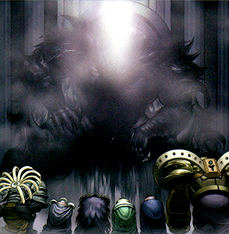
Mega Monarchs – The Emperors Strike Back!
If you haven’t figured it out yet, the Monarch theme was still very out of date at the point of introduction to the first Mega Monarch in Shadow Specters. This was the start of legacy support for the theme, as each Mega Monarch was released alongside a Spell or Trap card (featuring that Mega Monarch in its art) that was designed to give Tribute 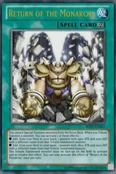 Summon decks the edge they needed against the meta. Whether it was search power in the form of Return of the Monarchs, disruption in the form of The Monarchs Erupt, protection in the form of The Monarchs Awaken, or even removal in the form of The Monarchs Stormforth, this support was designed to give these Mega Monarch the power to burst back onto the scene. They even brought over a lesson from the Steelswarm archetype, giving the Mega Monarchs ways to be Tribute Summoned with only 1 tribute instead of 2! But yet again, they failed to meet every single challenge head on with this new support. To have a Tribute Summon theme, they needed to have access to the monsters themselves (gated by an initial Tribute Summon due to the searcher Return of the Monarchs), they still needed to have the initial tribute fodder to begin with, and with the rise in importance of monster effects, they needed ways to combat the ever-growing arsenal of responses to monster effects. Sadly, there was no way for these new Mega Monarchs to rise to the occasion – the odds were simply not in their favor, despite having such strong effects for being Tribute Summoned to compensate for the loss in card advantage.
Summon decks the edge they needed against the meta. Whether it was search power in the form of Return of the Monarchs, disruption in the form of The Monarchs Erupt, protection in the form of The Monarchs Awaken, or even removal in the form of The Monarchs Stormforth, this support was designed to give these Mega Monarch the power to burst back onto the scene. They even brought over a lesson from the Steelswarm archetype, giving the Mega Monarchs ways to be Tribute Summoned with only 1 tribute instead of 2! But yet again, they failed to meet every single challenge head on with this new support. To have a Tribute Summon theme, they needed to have access to the monsters themselves (gated by an initial Tribute Summon due to the searcher Return of the Monarchs), they still needed to have the initial tribute fodder to begin with, and with the rise in importance of monster effects, they needed ways to combat the ever-growing arsenal of responses to monster effects. Sadly, there was no way for these new Mega Monarchs to rise to the occasion – the odds were simply not in their favor, despite having such strong effects for being Tribute Summoned to compensate for the loss in card advantage.
This is the point in our story where things get really interesting – the card designers actually took a novel approach to solving their design problems. The TCG card designers took the approach of further S/T support, throwing TCG World Premiere cards each set, giving the deck a wider arsenal and potential for success. The first attempt was The 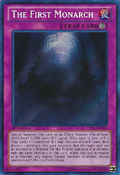 First Monarch, a 1-card tribute fodder for all of the Mega Monarchs that could also trigger their additional effect(s) since it could change attribute. Then the TCG followed with Escalation of the Monarchs, giving all Tribute Summon decks a way to Tribute Summon during the opponent’s turn. However, there just wasn’t enough time for the TCG to continue pumping support into the theme, as the Arc-V era began with a new formula for TCG World Premiere cards – the Burning Abyss and the Ultra Athletes were taking the limelight away. With no more room to play with and no competitive results, the TCG designers gave up the dream of making their effective Tribute Summon deck. They only had made a solution to the singular Normal Summon per turn and the multi-purpose tribute fodder obstacle, thus their solution fell through.
First Monarch, a 1-card tribute fodder for all of the Mega Monarchs that could also trigger their additional effect(s) since it could change attribute. Then the TCG followed with Escalation of the Monarchs, giving all Tribute Summon decks a way to Tribute Summon during the opponent’s turn. However, there just wasn’t enough time for the TCG to continue pumping support into the theme, as the Arc-V era began with a new formula for TCG World Premiere cards – the Burning Abyss and the Ultra Athletes were taking the limelight away. With no more room to play with and no competitive results, the TCG designers gave up the dream of making their effective Tribute Summon deck. They only had made a solution to the singular Normal Summon per turn and the multi-purpose tribute fodder obstacle, thus their solution fell through.
So how did the OCG designers approach this challenge? They began by deciding that the Monarchs needed more effective tribute fodder, that way a deck built around the Monarch theme (now Archetype due to 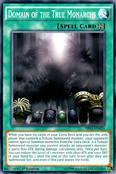 Tenacity of the Monarchs) could have some themed underlings to tribute away. Thus, the Vassals were created, one for each attribute. Each of these Vassals (except the oddball Escher) has two effects: the first to Special Summon itself from the hand and the second to provide some compensation for being used for a Tribute Summon. This was a great concept… but again, the OCG simply responded to the issue of tribute fodder ignoring the other issues. So, the OCG continued its support, this time in the form of Domain of the True Monarchs. Like they attempted to resolve by implementing the card design tactics used with the Steelswarm, Domain first intended to resolve the ‘multiple-tribute’ issue with the Level 8 Mega Monarchs in addition to adding its lockdown factor to curb the speed of the current meta. Again, this was a great attempt, but it did not reach the core of the issue for Monarch decks – the search power simply wasn’t there or effective enough. Thus, both regions attempted to solve the card design problems of a theme, turned it into an archetype, threw support from multiple angles… and yet nothing had succeeded. It seemed as though all was lost for the Monarchs… but since we all know the infamy that the archetype would soon achieve, you know their tale here isn’t yet over. But another attempt to bring Tribute Summoning into the spotlight had to come first, this time in the form of Duel Terminal code.
Tenacity of the Monarchs) could have some themed underlings to tribute away. Thus, the Vassals were created, one for each attribute. Each of these Vassals (except the oddball Escher) has two effects: the first to Special Summon itself from the hand and the second to provide some compensation for being used for a Tribute Summon. This was a great concept… but again, the OCG simply responded to the issue of tribute fodder ignoring the other issues. So, the OCG continued its support, this time in the form of Domain of the True Monarchs. Like they attempted to resolve by implementing the card design tactics used with the Steelswarm, Domain first intended to resolve the ‘multiple-tribute’ issue with the Level 8 Mega Monarchs in addition to adding its lockdown factor to curb the speed of the current meta. Again, this was a great attempt, but it did not reach the core of the issue for Monarch decks – the search power simply wasn’t there or effective enough. Thus, both regions attempted to solve the card design problems of a theme, turned it into an archetype, threw support from multiple angles… and yet nothing had succeeded. It seemed as though all was lost for the Monarchs… but since we all know the infamy that the archetype would soon achieve, you know their tale here isn’t yet over. But another attempt to bring Tribute Summoning into the spotlight had to come first, this time in the form of Duel Terminal code.
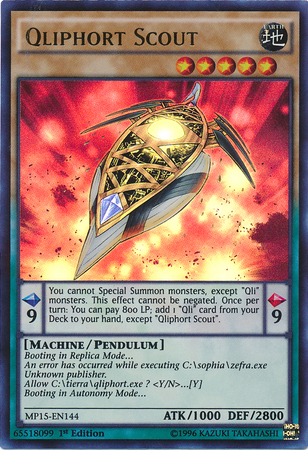
Attack of the Programs – The Qliphort Arrive:
What happens when card designers pull out all the stops to try and give Tribute Summoning decks the power to succeed? That’s right, you get a theme that duelists mistake for an aggressive beatdown deck. For the entirety of its 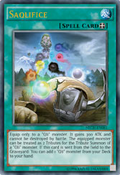 initial competitive impact, Qliphort decks were seen as disruption/control strategies that sent swarm after swarm of monsters supplied by Qliphort Scout and Saqlifice. While it was a Pendulum strategy at heart to sell the new mechanic, this was also very much an archetype designed to apply all of what they had learned about Tribute Summoning archetypes. First, it had the swarming capability to put the Tribute fodder onto your field without using the Normal Summon. Next, they had ways to reduce the number of Tributes required for stronger monsters through Saqlifice. The Qliphort even had the search power to grab the monsters you actually needed to summon in the form of Scout and Saqlifice. Due to design practices as well, the card designers also happened to provide an archetype almost entirely composed of monsters with matching stats to those of the Monarchs, so that way all of the existing Spell and Trap support could also be used to support the Qliphort. Not to mention
initial competitive impact, Qliphort decks were seen as disruption/control strategies that sent swarm after swarm of monsters supplied by Qliphort Scout and Saqlifice. While it was a Pendulum strategy at heart to sell the new mechanic, this was also very much an archetype designed to apply all of what they had learned about Tribute Summoning archetypes. First, it had the swarming capability to put the Tribute fodder onto your field without using the Normal Summon. Next, they had ways to reduce the number of Tributes required for stronger monsters through Saqlifice. The Qliphort even had the search power to grab the monsters you actually needed to summon in the form of Scout and Saqlifice. Due to design practices as well, the card designers also happened to provide an archetype almost entirely composed of monsters with matching stats to those of the Monarchs, so that way all of the existing Spell and Trap support could also be used to support the Qliphort. Not to mention 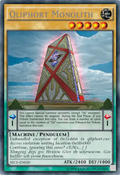 adding a Field Spell to provide a second Normal Summon per turn while also preventing any card effects from being activated that would negate the summon. To address the final obstacle for Tribute Summon decks, the entire Qliphort theme is Pendulum monsters; therefore it is a near-infinite supply of tribute fodder, and Helix/Carrier even give you effects when they are tributed. Not to mention Qliphort Monolith which also happens to let you draw additional cards for each monster that you tribute for Tribute Summons. In other words, every single problem that a Tribute Summon deck had in the past was solved by this archetype… making a well-oiled machine that quite frankly decimated formats, all puns intended. Then, since this theme clearly wasn’t powerful enough, every single monster was also given the ability to be summoned without Tribute, and the deck had many more powerful disruption tools at its disposal.
adding a Field Spell to provide a second Normal Summon per turn while also preventing any card effects from being activated that would negate the summon. To address the final obstacle for Tribute Summon decks, the entire Qliphort theme is Pendulum monsters; therefore it is a near-infinite supply of tribute fodder, and Helix/Carrier even give you effects when they are tributed. Not to mention Qliphort Monolith which also happens to let you draw additional cards for each monster that you tribute for Tribute Summons. In other words, every single problem that a Tribute Summon deck had in the past was solved by this archetype… making a well-oiled machine that quite frankly decimated formats, all puns intended. Then, since this theme clearly wasn’t powerful enough, every single monster was also given the ability to be summoned without Tribute, and the deck had many more powerful disruption tools at its disposal.
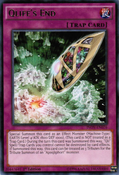 Now don’t get me wrong – this theme was not all bad. The intended direction of building up to the 3-tribute boss monsters was great, the Apoqliphort monsters were truly bosses to be reckoned with. The only problem was, the only decks in which they were used happened to be turbo variants which developed as future cards were released that happened to support our programmed machinery. Additionally, the final piece of support, Qlife’s End, was not released until Towers had been Forbidden. Again, too late to actually make a difference. In summary, while solving the issues of a Tribute Summon-centric strategy, the card designers shot for the moon and hit Mars. Too much power was invested into a strategy that had been competitively nonviable since the GX era, and thus, a more refined path to the perfect Tribute Summon archetype had to be crafted. And once they toned down the deck, the backup support to provide an alternate win condition simply wasn’t enough to catch the deck back up to the new meta. So, to keep with patterns and all, the card designers took yet another stab at the Monarch archetype, since it didn’t have nearly enough support already!
Now don’t get me wrong – this theme was not all bad. The intended direction of building up to the 3-tribute boss monsters was great, the Apoqliphort monsters were truly bosses to be reckoned with. The only problem was, the only decks in which they were used happened to be turbo variants which developed as future cards were released that happened to support our programmed machinery. Additionally, the final piece of support, Qlife’s End, was not released until Towers had been Forbidden. Again, too late to actually make a difference. In summary, while solving the issues of a Tribute Summon-centric strategy, the card designers shot for the moon and hit Mars. Too much power was invested into a strategy that had been competitively nonviable since the GX era, and thus, a more refined path to the perfect Tribute Summon archetype had to be crafted. And once they toned down the deck, the backup support to provide an alternate win condition simply wasn’t enough to catch the deck back up to the new meta. So, to keep with patterns and all, the card designers took yet another stab at the Monarch archetype, since it didn’t have nearly enough support already!
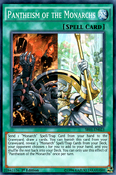
Return of the Monarchs (AGAIN!!!)
So what happens when you take a theme, pump 4 different waves of support into it, then decide you haven’t actually  given the theme enough to make it competitive? Well card designers decided to go all the way and make that theme meta. They invested enough design space into it after all, and they wanted the theme to pay off. So, they created the ultimate combo of support. The first was Pantheism of the Monarchs, giving the deck the speed it needed with a draw card that also happened to search a needed Spell or Trap support card. This also inadvertently helped the deck get to that first Tribute Summonable monster that it needed to begin the Return searches. Next, the deck introduced the tribute fodder in the form of Edea the Heavenly Squire and Eidos the Underworld Squire. Edea summons Eidos or any of the now obsolete vassals straight from the deck when summoned and also adds a banished Monarch Spell or Trap card when it is sent to the Graveyard, so effectively it is tribute fodder that summons other tribute fodder while also compensating for any potential losses in card advantage. Then Eidos gives you an extra Tribute Summon (in addition to your turn’s Normal Summon) the turn it is Summoned, and can be banished from the Graveyard to Special Summon Edea or any of your obsolete vassals back from the Graveyard… which then summons another Eidos and so forth. In other words, it is the perfect looping tribute fodder that also address other problems with a Tribute Summon theme. But the support didn’t stop there, because the deck also needed more ways to get out tribute fodder! Hence, The Prime Monarch was introduced that could either give you an extra draw every single turn OR Special Summon itself as a monster to be tributed away during one of your summons. Again, multipurpose cards that solve the strategy’s challenges while providing even more!
given the theme enough to make it competitive? Well card designers decided to go all the way and make that theme meta. They invested enough design space into it after all, and they wanted the theme to pay off. So, they created the ultimate combo of support. The first was Pantheism of the Monarchs, giving the deck the speed it needed with a draw card that also happened to search a needed Spell or Trap support card. This also inadvertently helped the deck get to that first Tribute Summonable monster that it needed to begin the Return searches. Next, the deck introduced the tribute fodder in the form of Edea the Heavenly Squire and Eidos the Underworld Squire. Edea summons Eidos or any of the now obsolete vassals straight from the deck when summoned and also adds a banished Monarch Spell or Trap card when it is sent to the Graveyard, so effectively it is tribute fodder that summons other tribute fodder while also compensating for any potential losses in card advantage. Then Eidos gives you an extra Tribute Summon (in addition to your turn’s Normal Summon) the turn it is Summoned, and can be banished from the Graveyard to Special Summon Edea or any of your obsolete vassals back from the Graveyard… which then summons another Eidos and so forth. In other words, it is the perfect looping tribute fodder that also address other problems with a Tribute Summon theme. But the support didn’t stop there, because the deck also needed more ways to get out tribute fodder! Hence, The Prime Monarch was introduced that could either give you an extra draw every single turn OR Special Summon itself as a monster to be tributed away during one of your summons. Again, multipurpose cards that solve the strategy’s challenges while providing even more!
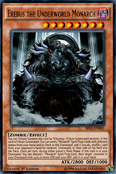 Next, the deck needed a bit more of a push, so the card designers must have figured that they needed to close with a duo of powerful Monarchs to thrive with all this new support. Ehther, the Heavenly Monarch, upon being Tribute Summoned, lets you setup your Graveyard with Monarch Spell/Trap cards to Special Summon any Monarch from your deck, before returning that summoned monster to the hand at the End Phase (in other words a glorified searcher), while also having the ability to be Tribute Summoned during the opponent’s turn. On the other hand, Erebus, the Underworld Monarch gives you non-targeting removal while setting up your Graveyard with Monarch Spell/Trap cards, and also lets you recycle your Monarch monsters back
Next, the deck needed a bit more of a push, so the card designers must have figured that they needed to close with a duo of powerful Monarchs to thrive with all this new support. Ehther, the Heavenly Monarch, upon being Tribute Summoned, lets you setup your Graveyard with Monarch Spell/Trap cards to Special Summon any Monarch from your deck, before returning that summoned monster to the hand at the End Phase (in other words a glorified searcher), while also having the ability to be Tribute Summoned during the opponent’s turn. On the other hand, Erebus, the Underworld Monarch gives you non-targeting removal while setting up your Graveyard with Monarch Spell/Trap cards, and also lets you recycle your Monarch monsters back 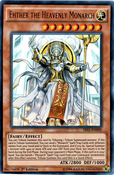 from the Graveyard once it gets there. I understand that this description of these support cards might seem as though I am just highlighting the strengths of these cards, but this batch of support truly was ridiculous in pushing the theme over the edge. Monarchs were subsequently hit hard by the Forbidden/Limited List because once again, the card designers had achieved their goal of resolving every issue with a Tribute Summon-centric theme, but by taking the archetype way too far. In fact, the one downside to Monarchs that was quickly discovered was the inconsistency when playing the archetype, even though it had so much power and deck-thinning and speed. I don’t think I need to harp on this archetype any further, so we can finally move onto the entire reason for this article – the True King/True Draco archetype.
from the Graveyard once it gets there. I understand that this description of these support cards might seem as though I am just highlighting the strengths of these cards, but this batch of support truly was ridiculous in pushing the theme over the edge. Monarchs were subsequently hit hard by the Forbidden/Limited List because once again, the card designers had achieved their goal of resolving every issue with a Tribute Summon-centric theme, but by taking the archetype way too far. In fact, the one downside to Monarchs that was quickly discovered was the inconsistency when playing the archetype, even though it had so much power and deck-thinning and speed. I don’t think I need to harp on this archetype any further, so we can finally move onto the entire reason for this article – the True King/True Draco archetype.
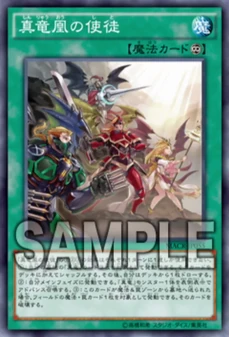
Is the True Draco the Archetype we have been waiting for?
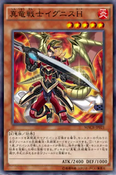 Well, I definitely did not expect to have written this much article leading up to this point, but looking back, I am glad that I explained each progression in card design over the years towards this moment. Because the True King/True Draco archetype (current Organization translations) is about to be the first archetype that has completely surprised me in terms of effectiveness from initial card reveals. For some of you reading this article, you may be completely unaware of this theme’s existence, so I’m going to begin with a quick rundown. This overall ‘True’ archetype is rich in lore but insanely connected via effects and themes. In fact, there are two main paths to build this archetype, one I will refer to as the True Kings and the other as True Draco, and these paths are determined exclusively by the monsters you choose to run.
Well, I definitely did not expect to have written this much article leading up to this point, but looking back, I am glad that I explained each progression in card design over the years towards this moment. Because the True King/True Draco archetype (current Organization translations) is about to be the first archetype that has completely surprised me in terms of effectiveness from initial card reveals. For some of you reading this article, you may be completely unaware of this theme’s existence, so I’m going to begin with a quick rundown. This overall ‘True’ archetype is rich in lore but insanely connected via effects and themes. In fact, there are two main paths to build this archetype, one I will refer to as the True Kings and the other as True Draco, and these paths are determined exclusively by the monsters you choose to run.
To begin, there are four True Kings – one for each elemental attribute – each that has a similar effect. When one is in the hand, you can destroy 2 other monsters you control or that are in your hand (one of which must share its attribute) in order to special summon that True King from the  hand. In addition, if both monsters you destroyed are of the same attribute, you get an additional bonus non-targeting, banishing effect. The second effect of each of these monsters is triggered whenever it is destroyed, Special Summoning a Wyrm of a different attribute or adding a non-WIND Wyrm to your hand. On the other hand, there are 6 True Dracos, and these are the monsters I will be focusing on because they are the core of our Tribute Summon deck. Their first effect is shared among all – each of these True Dracos can be Tribute Summoned using monsters OR Continuous Spells/Traps as tribute fodder. This is awesome, and should give you a hint as to how this theme was specifically designed with all of the Tribute Summon principles in mind. The rest of the effects of these monsters vary, so I am just going to provide a link to the Wikia Page for your reference if you have not been exposed to these cards yet: Click Here.
hand. In addition, if both monsters you destroyed are of the same attribute, you get an additional bonus non-targeting, banishing effect. The second effect of each of these monsters is triggered whenever it is destroyed, Special Summoning a Wyrm of a different attribute or adding a non-WIND Wyrm to your hand. On the other hand, there are 6 True Dracos, and these are the monsters I will be focusing on because they are the core of our Tribute Summon deck. Their first effect is shared among all – each of these True Dracos can be Tribute Summoned using monsters OR Continuous Spells/Traps as tribute fodder. This is awesome, and should give you a hint as to how this theme was specifically designed with all of the Tribute Summon principles in mind. The rest of the effects of these monsters vary, so I am just going to provide a link to the Wikia Page for your reference if you have not been exposed to these cards yet: Click Here.
 Now, the next part of this archetype is the Spell/Trap support, which simply happens to support both themes that compose the archetype. The Field Spell, Dragonic Diagram, allows you to destroy any card on the field or in your hand to add any ‘True King’ or ‘True Draco’ card to your hand, whether monster or support card. It also gives your Dracos a boost of 300 to both ATK and DEF, while preventing Tribute Summoned True Draco monsters from being destroyed by battle once per turn. Disciples of the True Dracophoenix and True Draco Succession serve as the Continuous Spell card support of the strategy. The first lets you shuffle 3 ‘True King’ or ‘True Draco’ cards from your Graveyard to the Deck to draw 1 card each turn, and the second lets you draw up to 3 cards each turn. Additionally, you can activate either to have an additional Tribute Summon of a True Draco monster during your Main Phase. Finally, whenever either is sent to the Graveyard, you get to destroy a Spell/Trap card on the field. On the other hand, Apocalypse of the True Dracos and Revival of the True King serve as the Continuous Trap card support of the strategy. The first lets you destroy a True Draco card to halve the ATK of all monsters your opponent controls, while the second lets you Special Summon any True Draco monster from your Graveyard as your final Special Summon for the turn. Additionally, you can activate either to have an additional Tribute Summon of a True Draco monster during your opponent’s Main Phase. Lastly, whenever either is sent to the Graveyard, you get to destroy a monster on the field.
Now, the next part of this archetype is the Spell/Trap support, which simply happens to support both themes that compose the archetype. The Field Spell, Dragonic Diagram, allows you to destroy any card on the field or in your hand to add any ‘True King’ or ‘True Draco’ card to your hand, whether monster or support card. It also gives your Dracos a boost of 300 to both ATK and DEF, while preventing Tribute Summoned True Draco monsters from being destroyed by battle once per turn. Disciples of the True Dracophoenix and True Draco Succession serve as the Continuous Spell card support of the strategy. The first lets you shuffle 3 ‘True King’ or ‘True Draco’ cards from your Graveyard to the Deck to draw 1 card each turn, and the second lets you draw up to 3 cards each turn. Additionally, you can activate either to have an additional Tribute Summon of a True Draco monster during your Main Phase. Finally, whenever either is sent to the Graveyard, you get to destroy a Spell/Trap card on the field. On the other hand, Apocalypse of the True Dracos and Revival of the True King serve as the Continuous Trap card support of the strategy. The first lets you destroy a True Draco card to halve the ATK of all monsters your opponent controls, while the second lets you Special Summon any True Draco monster from your Graveyard as your final Special Summon for the turn. Additionally, you can activate either to have an additional Tribute Summon of a True Draco monster during your opponent’s Main Phase. Lastly, whenever either is sent to the Graveyard, you get to destroy a monster on the field.
Now that you’re acquainted with the theme and its support, let’s take a step back and analyze this based on the challenges to Tribute Summon themes that we have discussed throughout this entire article. First was the issue of tribute fodder. Well, you have plenty due to the endless summoning of Revival, or the ability of any of your monsters to be Tribute Summoned using Continuous  Spell/Trap cards. Remember, you can even do that if the Continuous cards are set! Next, there needed to be a way to search whichever monster you wanted to Tribute Summon whenever conditions were right, and that is easily covered by the Field Spell of the archetype or the Normal Trap Card, Ethereal Wyrmterfall. Then, we needed to be able to conserve card advantage when tribute summoning, and every single Continuous card has a way of taking an opponent’s card down with it. Additionally, the Spell cards let you draw extra cards each turn and Revival lets you gain 1 True Draco back from the Graveyard every turn. Lastly, you have plenty of ways to achieve multiple Normal Summons per turn using in-theme support. But to be frank, the deck doesn’t have too much additional excess power. It has disruption options available of course, but this is a deck that is designed with the same goals and win conditions of the Qliphort archetype without all the extra bells and whistles. This comparison only continues when you consider the two boss monsters of the True Draco archetype – as each of them happen to become entirely immune when Tribute Summoned, just like Apoqliphort Towers.
Spell/Trap cards. Remember, you can even do that if the Continuous cards are set! Next, there needed to be a way to search whichever monster you wanted to Tribute Summon whenever conditions were right, and that is easily covered by the Field Spell of the archetype or the Normal Trap Card, Ethereal Wyrmterfall. Then, we needed to be able to conserve card advantage when tribute summoning, and every single Continuous card has a way of taking an opponent’s card down with it. Additionally, the Spell cards let you draw extra cards each turn and Revival lets you gain 1 True Draco back from the Graveyard every turn. Lastly, you have plenty of ways to achieve multiple Normal Summons per turn using in-theme support. But to be frank, the deck doesn’t have too much additional excess power. It has disruption options available of course, but this is a deck that is designed with the same goals and win conditions of the Qliphort archetype without all the extra bells and whistles. This comparison only continues when you consider the two boss monsters of the True Draco archetype – as each of them happen to become entirely immune when Tribute Summoned, just like Apoqliphort Towers.
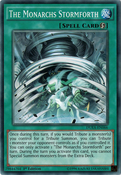
Where will designers go from here?
The Tribute Summon mechanic has been extensively explored since its early introduction to the game, so a natural question is simply wondering what comes next. This is where I have absolutely no answers, because I have no idea what they will do if the card designers ever decide to return to a theme involving Tribute Summoning. As we’ve seen TCG-side with the Kozmo, Kaiju, and now Subterror, Tribute Summoning simply isn’t the fad and higher leveled boss monsters are now accessed almost exclusively by Special Summoning. Additionally, I also worry that we will never see another innovative attempt to create a Tribute Summon-focused archetype again, because the formula that composed the Qliphort archetype was apparently enough to re-use for the True Draco 3 years later. One can only hope that the card designers come up with something brand new the next time they attempt to utilize this mechanic.
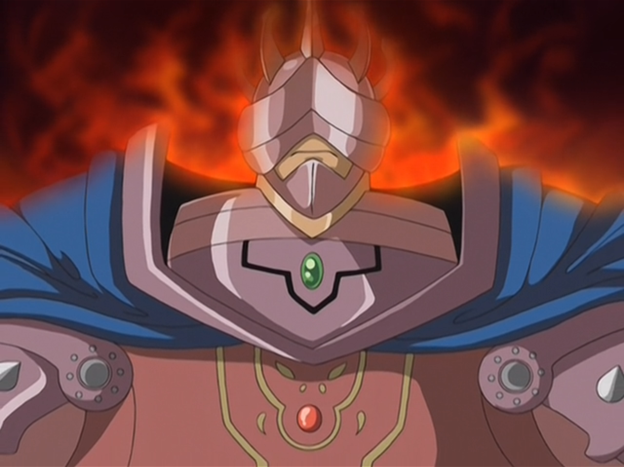
Hopefully you enjoyed learning about the evolution of the execution of the Tribute Summon mechanic, how it developed, the various approaches to the limited number of dedicated archetypes, and the incoming Tribute Summon theme known as the True Draco! I realize this isn’t one of my normal CDS articles, but I plan on bring some of those back in the near future! Thanks for reading and until next time!
